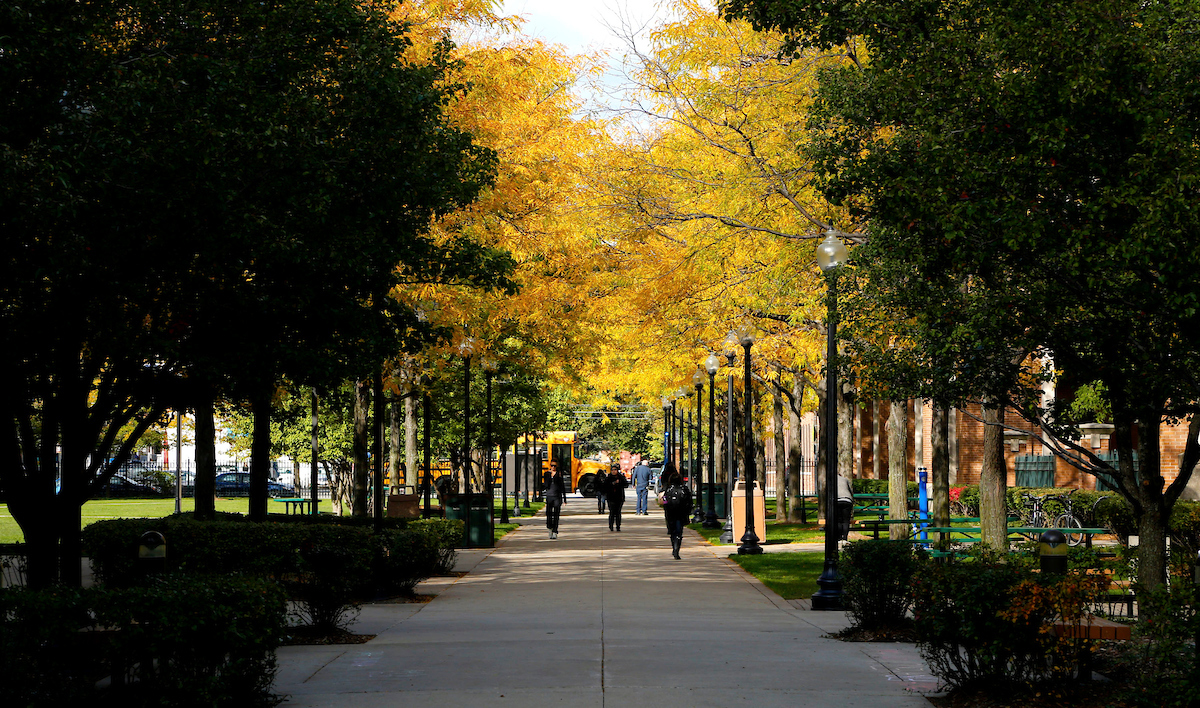 DePaul's Lincoln Park CampusIncreasing competition, rising costs, flat or declining populations in several key markets, and an unsettled budgetary environment in Illinois have made enrollment outcomes more unpredictable for all colleges and universities, and DePaul is no exception. In the face of mounting external pressures, the university enrolled 23,110 students this fall, or 99.6 percent of the projected target.
DePaul's Lincoln Park CampusIncreasing competition, rising costs, flat or declining populations in several key markets, and an unsettled budgetary environment in Illinois have made enrollment outcomes more unpredictable for all colleges and universities, and DePaul is no exception. In the face of mounting external pressures, the university enrolled 23,110 students this fall, or 99.6 percent of the projected target."This year's results are positive in many ways," says David Kalsbeek, senior vice president of Enrollment Management and Marketing. "DePaul generated a university record $225.8 million in tuition revenue this fall while also enrolling more students of color than at any time in its history. As a mission-driven institution that is highly dependent on tuition revenue to finance its operations, these are both important outcomes."
This fall, 8,316 of the students enrolled (or 36 percent) are students of color - the highest number of students of color and the highest proportion in DePaul's history. Students of color account for 39 percent of undergraduate enrollment, 30 percent of graduate enrollment and 27 percent of law enrollment.
Graduate enrollment also is one of the highlights this fall. The 6,897 graduate students are three percent (or 180 students) over budget and one percent over last year, the first year-over-year increase since graduate enrollment peaked in 2010. Graduate credit hours exceed the budgeted goal by six percent. New graduate enrollment of 1,778 students is two percent above the budgeted target, while credit hours are 15 percent over budget. In the largest graduate colleges, overall enrollment in CDM is stable and the number of new graduate students in Kellstadt is up 16 percent over last year.
The College of Law enrolled 321 new students, 51 (or 19 percent) more than budgeted and 43 (or 15 percent) more than last year. Overall, law enrollment of 806 students is about nine percent over budget and nearly four percent greater than last year. Although it is a small percentage of university enrollment, it is a notable outcome after six straight years of declines.
"While we try to meet or exceed expectations in every student category, we are seeing more volatility this fall," Kalsbeek states. "Past results are an increasingly less reliable indicator of future outcomes, which is creating greater uncertainty in enrollment planning."
This proved especially true at the undergraduate level. Undergraduate enrollment is 15,407 students, about 2 percent (or 333 students) under this year's budgeted goal of 15,740. Over half of the difference between actual and target headcount can be attributed to a decline in new transfer students. Transfer enrollment of 1,222 is 13 percent less (178 students) than the budgeted level and 16 percent less than last year.
"DePaul has the highest market share of any private university for community college transfers from the state of Illinois, and that share has been steadily increasing over the last 10 years," explains Jon Boeckenstedt, associate vice president of EMM. "The size of that transfer population (from Illinois community colleges), however, has been declining sharply. These divergent factors make transfer recruitment, which has been a significant part of our undergraduate success historically, more challenging."
While freshman enrollment also faces growing competitive pressures, DePaul secured a record number of applications for admission and the 2,459 new freshmen this year are only 1.7 percent less than the budgeted target. Concerns about the state's MAP grant program and increased tuition discounting by competitors were important factors affecting the outcome.
"The lack of clarity surrounding MAP grant funding makes the college selection process more difficult for students," says Paula Luff, associate vice president of Enrollment Services in EMM. "College is a big investment and families want certainty. If they cannot count on the financial support they are expecting, they look for other alternatives. This dynamic is affecting nearly every university, especially public institutions, across the state. And we are not immune from it."
The freshman class' academic quality remains strong, with an average high school GPA of 3.55 and an average ACT score of 25.3. The class is among the most diverse ever at DePaul, with students of color comprising 38 percent of the class, first-generation students 32 percent and out-of-state students 40 percent.
Many of these external factors will persist in the foreseeable future and shape DePaul's strategic and financial planning.
"We can no longer expect the levels of significant annual growth in enrollment and revenue that we've known in the past. But DePaul has a history of successfully navigating changing market conditions, and being able to deliver, demonstrate and differentiate the value of a DePaul education will be most critical going forward," Kalsbeek says. "We have a strong brand and a wide portfolio of academic programs, but our focus on improving the experience and outcomes our students realize for their tuition dollar must be unrelenting."